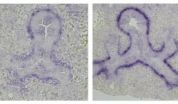(Press-News.org) PROVIDENCE, R.I. [Brown University] — Scientists, including Brown University geologists and students, have completed the first global geological map of Ganymede, Jupiter's largest moon and the largest in the solar system.
With its varied terrain and possible underground ocean, Ganymede is considered a prime target in the search for habitable environments in the solar system, and the researchers hope this new map will aid in future exploration. The work, led by Geoffrey Collins, a Ph.D. graduate of Brown now a professor at Wheaton College in Massachusetts, took years to complete. The map was published today by the U.S. Geological Survey.
"It is very rewarding to see the results of all of our efforts here at Brown come together into this integrated global compilation that will now be used to plan the next phase of scientific exploration of the Galilean satellites," said Jim Head, the Scherck Distinguished Pprofessor of Geological Sciences at Brown and one of the map's co-authors.
The researchers combined images from the Voyager and Galileo spacecraft to put the map together. Voyager was the first mission to fly through the Jupiter satellite system and passed by the icy surface of Ganymede in 1979. Those first images revealed a complex surface, segmented and fractured into dark and light terrain. In 1995, the Galileo spacecraft was placed in orbit around Jupiter and began to return high-resolution images of the surface that help to understand many of the features seen at low-resolution by Voyager.
Head was a co-investigator on the Galileo's Solid State Imaging (SSI) experiment. In that role, he and his team were responsible for planning the imaging sequences for Ganymede in order to identify and investigate the scientific targets of highest priority. The team worked for several years to obtain the data necessary to make the global map.
"This was an amazing time," Head said. "Brown graduate and undergraduate students worked shoulder-to-shoulder in the Planetary Geosciences Laboratory in Lincoln Field Building, studying the newly acquired images and choosing new sites of scientific interest. The discoveries were daily and the adrenaline was surging as we rushed to collect our thoughts and plans, review them with the SSI Team, and get them uploaded to the spacecraft in time for the next encounter."
Geoffrey Collins was one of the graduate students looking at the data as it came in from Galileo. Wes Patterson and Louise Prockter, now at the Johns Hopkins University Applied Physics Laboratory, also started work on the project as graduate students at Brown. Robert Pappalardo, now at NASA's Jet Propulsion Lab, was part of the team during postdoctoral studies at Brown.
"I'm so glad all that work has paid off in the form of this detailed global map," Head said. "It is equally rewarding to see that the Brown team has now moved on to positions of leadership in the planetary exploration research community."
INFORMATION:
Researchers create first global map of Ganymede
2014-02-13
ELSE PRESS RELEASES FROM THIS DATE:
Penn geophysicist teams with mathematicians to describe how river rocks round
2014-02-13
For centuries, geologists have recognized that the rocks that line riverbeds tend to be smaller and rounder further downstream. But these experts have not agreed on the reason these patterns exist. Abrasion causes rocks to grind down and become rounder as they are transported down the river. Does this grinding reduce the size of rocks significantly, or is it that smaller rocks are simply more easily transported downstream?
A new study by the University of Pennsylvania's Douglas Jerolmack, working with mathematicians at Budapest University of Technology and Economics, ...
Happy couples can get a big resolution to a big fight -- mean talk aside
2014-02-13
Being critical, angry and defensive isn't always a bad thing for couples having a big disagreement — provided they are in a satisfying relationship. In that case, they likely will have a "big resolution" regardless of how negative they were during the discussion, according to a study by a Baylor University psychologist.
Until now, there have been two opposing ideas on negative communication in conflict: one is to refrain from using it, while the other suggests doing so is a natural part of productive interaction to resolve conflict. But findings from the latest research ...
Dartmouth study shows US Southwest irrigation system facing decline after 4 centuries
2014-02-13
Communal irrigation systems known as acequias that have sustained farming villages in the arid southwestern United States for centuries are struggling because of dwindling snowmelt runoff and social and economic factors that favor modernism over tradition, a Dartmouth College study finds.
The results reflect similar changes around the world, where once isolated communities are becoming integrated into larger economies, which provide benefits of modern living but also the uncertainties of larger-scale market fluctuations. The study appears in the journal Global Environmental ...
Prenatal vitamin A deficiency tied to postnatal asthma
2014-02-13
NEW YORK, NY (February 12, 2014) — A team of Columbia University Medical Center (CUMC) investigators led by Wellington V. Cardoso, MD, PhD, has found the first direct evidence of a link between prenatal vitamin A deficiency and postnatal airway hyperresponsiveness, a hallmark of asthma. The study, conducted in mice, shows that short-term deficit of this essential vitamin while the lung is forming can cause profound changes in the smooth muscle that surrounds the airways, causing the adult lungs to respond to environmental or pharmacological stimuli with excessive narrowing ...
Satellite video shows movement of major US winter storm
2014-02-13
VIDEO:
This animation of NOAA's GOES satellite data shows the progression of the major winter storm in the US south from Feb. 10 at 1815 UTC/1:15 p.m. EST to Feb. 12...
Click here for more information.
A new NASA video of NOAA's GOES satellite imagery shows three days of movement of the massive winter storm that stretches from the southern U.S. to the northeast.
Visible and infrared imagery from NOAA's GOES-East or GOES-13 satellite from Feb. 10 at 1815 UTC/1:15 p.m. EST to ...
Could restless sleep cause widespread pain in older folks?
2014-02-13
Researchers in the U.K. report that non-restorative sleep is the strongest, independent predictor of widespread pain onset among adults over the age of 50. According to the study published in Arthritis & Rheumatology (formerly Arthritis & Rheumatism), a journal of the American College of Rheumatology (ACR), anxiety, memory impairment, and poor physical health among older adults may also increase the risk of developing widespread pain.
Muscle, bone and nerve (musculoskeletal) pain is more prevalent as people age, with up to 80% of people 65 years of age and older experiencing ...
Sedation before nerve block increases risk, not pain relief
2014-02-13
New research suggests that sedating patients before a nerve block needed to diagnose or treat chronic pain increases costs, risks and unnecessary surgeries, and sedation does nothing to increase patient satisfaction or long-term pain control.
"Sedation doesn't help, but it does add expense and risk," says study leader Steven P. Cohen, M.D., a professor of anesthesiology and critical care medicine at the Johns Hopkins University School of Medicine. "In some places, every patient is being sedated. Our research shows it should be used very sparingly."
Nerve blocks, performed ...
Laboratory detective work points to potential therapy for rare, drug-resistant cancer
2014-02-13
PITTSBURGH, Feb. 13, 2014 – University of Pittsburgh Cancer Institute (UPCI) scientists have shown that old drugs might be able to do new tricks.
By screening a library of FDA-approved anticancer drugs that previously wouldn't have been considered as a treatment for a rare type of cancer, UPCI scientists were surprised when they found several potential possibilities to try if the cancer becomes resistant to standard drug treatment.
The discovery, which will be published in the February 15th issue of Cancer Research, demonstrates that high-throughput screening of already ...
Researchers find source of new lineage of immune cells
2014-02-12
The elusive progenitor cells that give rise to innate lymphoid cells—a recently discovered group of infection-fighting white blood cells—have been identified in fetal liver and adult bone marrow of mice, researchers from the University of Chicago report early online in the journal Nature.
Innate lymphoid cells (ILCs) are among the first components of the immune system to confront certain pathogens. They have a critical function at mucosal barriers—locations such as the bowel or the lung—where the body comes in direct contact with the environment. Yet they went undetected ...
NREL report finds similar value in 2 CSP technologies
2014-02-12
Parabolic troughs and dry-cooled towers deliver similar value for concentrating solar power (CSP) plants, despite different solar profiles, a new report by the Energy Department's National Renewable Energy Laboratory has found.
The report, "Estimating the Performance and Economic Value of Multiple Concentrating Solar Power Technologies in a Production Cost Model," found that the value of delivered energy of dry-cooled tower and parabolic trough CSP plants, integrated with thermal energy storage, are quite similar.
CSP with thermal energy storage is a unique source of ...





